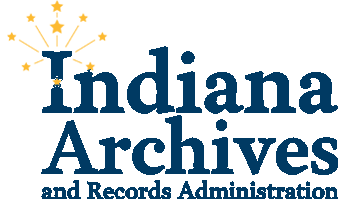Indiana's 1816 Constitution is back home again after a face lift in Bloomington. Indiana State Police returned the historic document to the State Archives on November 15, 1995, just in time for its 179th birthday.
Forty-three delegates from Indiana's thirteen existing counties met in Corydon in June of 1816 to draft a constitution for the new state of Indiana. Using Ohio and Kentucky's constitutions as models, they drafted a document in just eighteen days. Two handwritten copies of the Constitution were made by Dr. David H. Maxwell, a delegate from Jefferson County. One of these was given to Jonathan Jennings, President of the Constitutional Convention and Indiana's first Governor. On November 11, 1816, Jennings delivered the copy to the first General Assembly, which ordered it to be deposited with the Secretary of State. Both copies were "handsomely bound in morocco and gilt" in 1826 by then Secretary of State William Wickes. One copy of the Constitution was transferred to the Indiana State Library in 1934. It remained in the Library's possession until 1979, when responsibility for its preservation was conveyed to the Indiana State Archives.
By 1992, the 1816 Constitution was showing its age. The original sheepskin binding had faded and dried out, showing early signs of crumbling. The binding's joints (the flexible junction where the cover and spine meet) were worn and loose. Internally, the once sturdy pages were limp and lifeless. The edges and folds of the paper sheets were chipped and torn. Fingerprints and stains were visible on many pages and the high acidic level of the iron gall ink used in writing the document had corroded the paper. More serious in nature were the trimmed fore-edges of the sheets, possibly done at the time of binding to produce a uniform sheet size. However, cropping the edges of the Constitution's pages, which already had small margins, resulted in cutting away parts of the text.
To meet this crisis, James E. Farmer, first President of the Friends of the Indiana State Archives, approached the Indiana Bar Foundation for a grant to restore the Constitution. Recognizing the importance of this unique document, the Bar Foundation responded positively.
The 1816 Constitution was restored by conservator James Canary, of Bloomington, using the conservation laboratory of Indiana University's Lilly Library. William Cagle, the Lilly Librarian, graciously offered these facilities to ensure the security of the Constitution while out of the State Archives. On August 31, 1995, Indiana State Police transported the Constitution to Bloomington, accompanied by Archives' preservation staff Marta O'Neill, who prepared the contract for restoration, and Jean Bennett.
Canary began restoration work by separating the pages from the binding and removing the thread which held the pages together. The pages were first washed in de-ionized water, then deacidified using a methyl magnesium carbonate applied with a spray gun to neutralize the paper's inherent acids. As a result, the pages are now clean and crisp.
Contrary to Secretary Wickes' report, the Constitution is bound in sheepskin rather than "morocco," which is made from goatskin. The original color of the binding could not be restored without altering the document's physical integrity. Thus, Canary opted for a conservative approach and merely oiled the original leather to revive its suppleness. The joints were repaired by lifting away the original spine leather, adding new leather underneath and attaching it to the front and back covers, then laying the spine leather back down over the new. As a last step, Canary restitched the original pages back together with new thread and reattached them to the covers.
Interestingly, at least two different types of paper were used to transcribe the various sections of the Constitution. One paper stock had a higher acid content and its sheets were brown in color, while the second paper stock was a cream color.
The restored Constitution was unveiled at a grand ceremony in the State House on December 11--Indiana Statehood Day. A color guard from the Indiana Sons of the American Revolution--in authentic uniforms--provided an historic context. William Doherty, president of the Friends of the Indiana State Archives, presided over the ceremony. Speakers included Matthew Gutwein, representing Indiana Governor Evan Bayh, Indiana Chief Justice Randall T. Shepard; Frank E. Tolbert, President of the Indiana Bar Foundation; State Representative Ralph M. Foley; constitutional historian John Bremer; and State Archivist F. Gerald Handfield. Among the special guests present were former Governor Robert D. Orr and State Treasurer Joyce Brinkman.
A version of this article appeared in Archives Current, The Newsletter of the Friends of the Indiana State Archives., Inc., Vol. 1, No. 2, Winter 1996.
